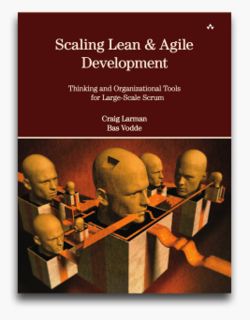Organizational Design Implications of Large-Scale Scrum and Agile Development - An Executive Seminar
Contents
Overview
2 days
Because (real) Large-Scale Scrum (LeSS) is a profound organizational design change, I -- my work is best described as organizational design consulting -- need to start with the senior management that have the remit to deeply change the system. This can't be done bottom up, because real Scrum implies the elimination of various traditional groups, roles, and policies, that only (typically) C-level mgmt have the authority to eliminate and replace. If one were to incorrectly try to do this with middle or first-level management, it will be a "fake change" or a "change ghetto" within a traditionally constrained system.
Consequently, it vitally important in step one of the change to LeSS for the senior leaders go through the in-depth learning with me necessary to grasp what the changes will be, driven by a deep systems-thinking understanding of the current system dynamics.
In short, before changing to LeSS, it is critical with the leadership to achieve deep understanding and agreement (or not) to the organizational change. That is, “informed consent.”
Audience
Participants should include all the senior managers that have complete control over the organizational design (structure, roles, positions, policies, processes), probably including C-level managers (CEO, COO, CTO, …), directors of R&D and of Product Mgmt, leaders and key managers in the particular product group that is first going to change, functional-group managers ("architecture group manager", "test group managers", ...), project/program manager, team leads, release managers, and so forth. It is better if it is larger group than a smaller group, since changing to real Large-Scale Scrum will impact *everyone*.
Prerequisites
Read this: Pre-readings
Outline
- Large-Scale Thinking, Organization, and Action Tools
- Large-Scale Scrum (LeSS): Frameworks LeSS-1 & LeSS-2
- The LeSS Rules and Guides
- Adopting LeSS
- Organizational design & organizing by customer value
- Scaling with Requirement Areas
- Feature and component teams
- Scaling the Product Owner role, and Product Management
- Product Backlog in LeSS
- ScrumMasters @ Scale
- Scaling the Definition of Done, and organizational design implications
- Preparing for Sprint 1 @ Scale, and Initial Product Backlog Refinement
- Scaling Sprint Planning
- Scaling coordinating & integration within a Sprint
- Scaling Product Backlog Refinement
- Joint and multisite Sprint Reviews
- Joint and multisite Sprint retrospectives
- Large-scale estimation, release planning and scheduling
- Enterprise-level policies and systems that support agility
- Architecture & design in LeSS
- Hierarchical continuous integration systems
- Agile documentation in large products
- Agile offshoring
- Multisite and agile development
- Contracts
Maximum Participants
35
Methods of Consulting and Interaction
Causal-loop modeling, discussion, presentation, Q&A, workshop exercises
Environment - Room, Tools, Texts
Read this: Course Environment - Workshop Style1
